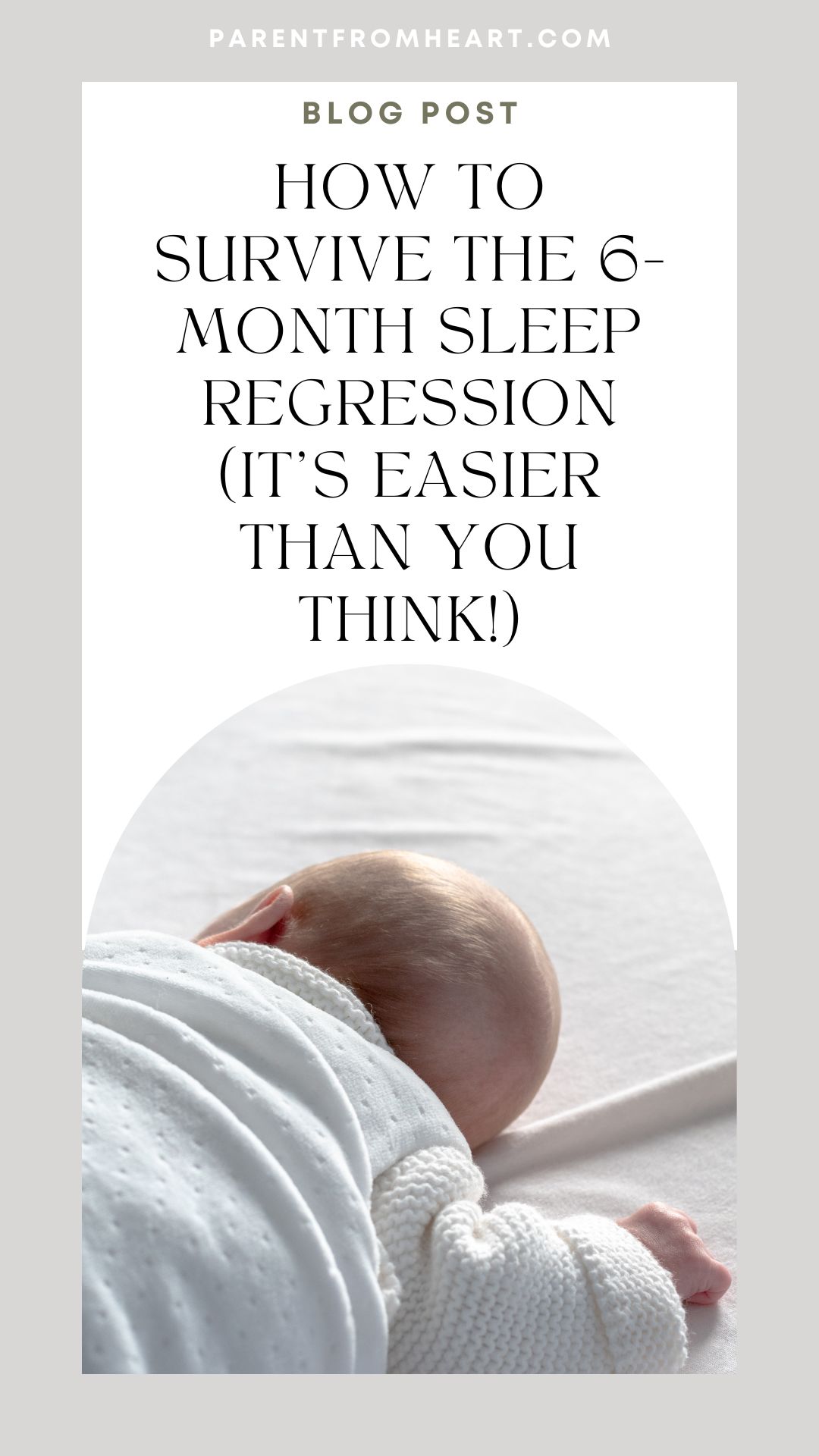Table of Contents
- Does sleep regression in babies happen only at the six-month mark?
- What causes sleep regression?
- How do I know if my baby’s sleep disruptions is caused by teething or sleep regression?
- When should I consult a pediatrician about my baby’s sleep problems?
- What is self-settling? How can it help my fussy baby?
- Will sleep regression keep my 6-month-old from getting enough sleep?
- What’s the ideal bedtime routine to help my 6-month-old get over sleep regression?
- What can I do when I feel overwhelmed by all these sleep disruptions of my 6-month-old baby?
- The intriguing silver lining
- The 6-month sleep regression, therefore, is normal; healthy even.
If there’s one thing that makes new parents feel like they’re going one step forward, two steps back, it’s sleep regression in babies. Your six-month-old has been sleeping almost five hours continuously for the past week. Then one day, without any kind of warning, he goes back to his newborn sleep pattern, dozing two hours at a time. Is this normal?
Yes it is, say sleep experts. Sleep regression is a natural part of your baby’s development so don’t worry, mom and dad. You are simply going through that period when your baby, who had been sleeping relatively well, suddenly becomes a fussy sleeper, fully waking multiple times during the night and their daytime naps.
Generally, this may last between a week to about a month. Provided there are no accompanying symptoms that your pediatrician may flag, this period is an expected step in your baby’s development.
Some scientists say sleep regressions shouldn’t even be considered an alarming issue. Waking up during the night then going back to sleep a couple of hours later is a human tendency at any age. Historian Roger Ekirch discovered this fact while studying medieval nighttime sleeping habits.
Despite this reassurance, it is understandable for new parents to be concerned about sudden changes in their baby’s sleep pattern. While not all babies experience sleep regression, it is a common enough phenomenon, which still isn’t universally understood. Let the answers to the following questions enlighten you.

Does sleep regression in babies happen only at the six-month mark?
Not always. Experts say sleep regression follows no strict, universal schedule, as is the case for many milestones for babies and toddlers. Generally, however, it may take place at around the ages of four, six, eight, 12 or 18 months and last for one to four weeks.
At four months old, your baby’s circadian rhythm is finally starting to develop. This causes them to become fully awake between sleep cycles when previously, they just sort of drifted from one cycle to the next.
At six months old, your baby is more mobile. Separation anxiety is a new phenomenon, as well as teething. Your baby is expending more energy, making them hungrier throughout the day and night, which wakes them up at all hours.
At eight months old, your baby has learned to pull themselves up. They are trying out some syllables (or even whole words!). Because of all the activity, they are likely to drop at least one of their naps, which puts a wrench into their sleep pattern.
At a year old, your baby is more aware of the world around them. If your baby experiences sleep regression at this age, it will most likely be barely noticeable.
Sleep regression at a year-and-a-half is usually the last one. At this point, sleep disruptions will be caused by several major life changes for your tot: potty training, outgrowing their crib, discovering their imagination, and getting attached to their caregivers.
All in all, when sleep regression starts and how long the disruptions occur depend on the baby’s biological makeup. Alice Gregory, sleep expert and psychology professor at Goldsmiths, University of London explains it succinctly: “Just as adults differ in their sleep, so do babies.”
What causes sleep regression?
One main cause of this sleep phenomenon is your baby hitting their growth milestones. As their brain develops and motor skills mature, the transitions may cause disruptions in their sleep. They’re learning new things and discovering more of their surroundings. Beginning at six months of age, your baby is more vocal—laughing and babbling. They’ll be rolling over and may already be sitting upright. Your baby wants to be up for all of that. This is good news (except that you have to be up for all of it, too).
On the other hand, your baby may also be experiencing sleep regression because they are unwell. They could also be going through sudden changes in their routine, such as travel.

How do I know if my baby’s sleep disruptions is caused by teething or sleep regression?
If your baby’s sleep disruptions come with several symptoms, such as drooling, irritability, swollen gums, ear pulling, and a change in eating habits, then they’re most probably teething. It’s best to check with your pediatrician to make sure.
With sleep regression at six months old, especially, come developmental milestones—for instance, crawling for the first time, recognizing more faces, starting to communicate. Other telltale signs that indicate sleep regression include:
- A general fussiness that is not caused by teething, tiredness, hunger, or being unwell
- Shorter naps during the day
- Resistance to bedtime or daytime naps
- Difficulty in going back to sleep when they wake at night
When should I consult a pediatrician about my baby’s sleep problems?
While sleep regression in babies is generally normal, it may be time to see your pediatrician if it comes with the following issues:
- A sudden lack of appetite
- Less frequent urination or bowel movements
- Difficulty in breathing
- A lack of weight gain
If the regression lasts for more than a month, but your baby isn’t displaying any other symptoms, It’s still a good idea to schedule a well-baby visit with your pediatrician. Since babies cannot yet verbalize how they are feeling, it’s best to have their doctor check.
What is self-settling? How can it help my fussy baby?
Self-settling is when parents let babies lull themselves to sleep from being fully awake. Unlike sleep training, where you leave your baby to cry until they fall asleep, with self-settling, you gradually stop helping your baby fall asleep.
By all means, rock them, sing to them, read them a bedtime story. But once they’re drowsy and still semi-awake, put them down on their bed. Let them drift off without your help so they stop associating your touch with sleep.
This is a valuable skill for your baby, especially when they are going through sleep regression. They will need to know how to get back to sleep without you. Around the four-month mark, your baby’s circadian rhythm—the body’s internal clock that dictates when it’s time to sleep and when it’s time to wake up—will begin developing. Only then can you start teaching them to self-settle. (Take note, though, that this doesn’t discount the effectivity of responsive parenting.)
It will take a few days to a few weeks for your baby to catch on. So be consistent and persistent. Help your baby out by making sure they are not over- or under-tired, or hungry, at bedtime. Stick to their bedtime routine every night.

Will sleep regression keep my 6-month-old from getting enough sleep?
Babies can sleep anywhere, anytime. Nighttime sleep isn’t their only source of rest. Besides, sleep regression is a passing phase. As your baby’s development and growth spurts find a more consistent rhythm, so will their sleep patterns. In other words, no, sleep regression will not keep your baby from getting enough sleep. If they are tired during the day after a fussy night, then, barring other issues, they will inevitably fall asleep when they need to.
In any case, if you feel that your six-month-old is not sleeping enough, see your pediatrician. But remember that they can sleep during the day and night. All these hours add up.

What’s the ideal bedtime routine to help my 6-month-old get over sleep regression?
There is actually no such thing as “getting over” sleep regression in babies since this temporary period of sleep disruptions is a normal, albeit frustrating, part of your baby’s development. All you and your baby can do is wait it out until the phase passes.
But setting up a relaxing bedtime routine as part of your six-month-old’s sleep schedule can be one way to make this period more bearable. A routine will help reinforce your baby’s circadian rhythm. For this routine to produce healthy sleep habits, consistency is key.
-
Begin with a warm bath about an hour and a half before bedtime.
Studies have linked better sleep quality with a warm bath or shower about 90 minutes before bedtime. Your baby isn’t exempted from this finding. An article produced by a team of biomedical engineers at the University of Texas in Austin discusses how body temperature directly contributes to the quality of a person’s sleep.
See, one of the regulators of your circadian rhythm is body temperature. About an hour before your usual sleep time, your body starts cooling down, a signal for your waking hours to wrap up.
Since your baby’s circadian rhythm is still undeveloped, it will need some prodding. A warm bath (98.6°F or between 37°C and 38°C) before bedtime will increase blood circulation to their hands and feet. This gradually lowers your baby’s body temperature, prompting sleep.
-
Feed your baby about 30 minutes before you put them to bed.
A grumbling tummy makes it difficult for you to sleep. It’s no different for babies. Pediatrician Heidi Szugye, who is also a breastfeeding expert, says feeding your baby before they lay down to sleep can make them drowsy.
Don’t forget to burp your baby when they’re done even after they fall asleep. Wind can disrupt even the deepest sleep of a well-rested infant.
-
Dim lights in the bedroom.
Just like body temperature, light helps regulate a person’s circadian rhythm. Bright lights signal daytime—i.e., playtime; lights off signal bedtime. Dim the lights in the bedroom right after your baby’s bath. By doing this consistently, your baby will eventually associate nighttime with bedtime. (Similarly, expose them to natural light during the day to help them distinguish waking hours from sleeping hours.)
Definitely keep any gadgets off during bedtime. In fact, keep your baby’s room free of mobile devices and TVs.
-
Play soft white noise.
Research has found that white noise—a mix of day-to-day sounds, such as falling rain, the hum of a fan, people talking softly—can help settle a restless baby. These sounds mimic those a baby hears as a fetus in the womb, therefore bringing them comfort. White noise frequency has also been found to drown out other frequencies that may disrupt your little one’s slumber. Try this baby sound machine, or this playlist of white noise for tonight.

What can I do when I feel overwhelmed by all these sleep disruptions of my 6-month-old baby?
Ask for help. Often, this is one of the hardest things for new parents to do because they want to do it all themselves, and to do it well. But to raise a child without losing yourself in the process, or burning out you will need help from your “village.”
It may come in the form of your partner, parents, grandparents, neighbors, or best friends. And when they come, remember to ask for specific help. Do you need someone to watch your baby for two hours while you catch up on sleep? Need someone to cook you a simple dinner? Listen while you unload your thoughts and fears? Do a couple loads of laundry?
While your village is pitching in, it’s vital for you to do something you love. Read a book. Catch up on sleep. Watch an episode of your favorite series. Enjoy a cup of coffee. It doesn’t matter what you do as long as you do it for yourself.
Taking care of your baby through sleep regression (and beyond) is difficult. Having a reliable support group is vital.

The intriguing silver lining
As you wade through the exhaustion brought about by sleep regression in babies, know that it brings one bright note: frequent sleep interruptions lower the risk of sudden infant death syndrome (SIDS).
Healthcare providers generally cite SIDS to explain why a previously healthy infant would pass away during sleep. The frequent wakings brought about by sleep regression largely removes this possibility.
James McKenna is the founder and director of the Mother-Baby Behavioral Sleep Laboratory at the University of Notre Dame. He theorizes that the risk of SIDS increases when parents insist their babies go back to sleep when the babies clearly aren’t ready to do that. When babies wake after sleeping for just 45 minutes, they are inadvertently putting themselves out of harm’s way.
But won’t frequently interrupted sleep have a negative effect on my child’s cognitive development, you might ask. Not likely, says a research team from the Department of Educational and Counselling Psychology at McGill University, Canada. Their study, published in the American Academy of Pediatrics, found “no associations…between uninterrupted sleep [and] mental or psychomotor development.”
The 6-month sleep regression, therefore, is normal; healthy even.
Some scientists even say this sleep phenomenon should be considered a myth. Babies wake during the night; that is their tendency as new humans.
Yes, it is exhausting and worrisome, at times. However, there are things you can do to make this temporary period more bearable. You can set up a bedtime routine, which you need to do consistently for it to create lasting results. There is also your village to tap when you need a break.
Remember to take comfort in the fact that this regression happens as a natural part of your baby’s growth and development. It is their body’s way of catching up to all the changes simultaneously going on. Your baby is experiencing new and exciting things every day; who wants to be asleep for any of it?
Besides, when your baby interrupts their own sleep frequently, it lowers their risk of SIDS. Hang on to this silver lining, mom and dad, when your baby wakes up for the seventh time tonight.
Tell us, though: how have you been dealing with the sleep regression of your six-month baby?
Like this post? Click on the image below to share this on Pinterest – Thank you!












